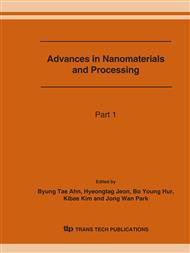p.587
p.591
p.595
p.599
p.603
p.607
p.611
p.615
p.619
Resistive Switching Characteristics in TiO2 ReRAM with Top Electrode of Co Selectively Formed on SAMs Printed Patterns
Abstract:
Simple process for the fabrication of Co/TiO2/Pt resistive random access memory, called ReRAM, has been developed by selective deposition of Co on micro-contact printed (μ-CP) self assembled monolayers (SAMs) patterns. Atomic Layer Deposition (ALD) was used to deposit TiO2 thin films, showing its ability of precise control over the thickness of TiO2, which is crucial to obtain proper resistive switching properties of TiO2 ReRAM. The fabrication process for Co/TiO2/Pt ReRAM involves the ALD of TiO2 on sputter-deposited Pt bottom electrode, followed by μ-CP with SAMs and then selective deposition of Co. This results in the Co/TiO2/Pt structure ReRAM. For comparison, Pt/TiO2/Pt ReRAM was produced and revealing the similar switching characteristics as that of Co/TiO2/Pt, thus indicating the feasibility of Co replacement with Pt top electrode. The ratios between the high-resistance state (Off state) and the low-resistance state (On state) were larger than 102. Consequently, the selective deposition of Co with μ-CP, newly developed in this study, can simplify the process and thus implemented into the fabrication of ReRAM.
Info:
Periodical:
Pages:
603-606
Citation:
Online since:
June 2007
Authors:
Keywords:
Price:
Сopyright:
© 2007 Trans Tech Publications Ltd. All Rights Reserved
Share:
Citation:


